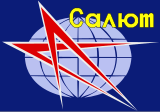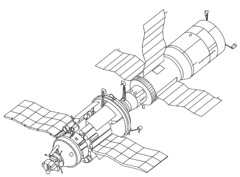Kosmos 1686

Kosmos 1686 (top) docked to Salyut 7, imaged by Range-Doppler radar.
|
|

Salyut program insignia
|
|
| Station statistics | |
|---|---|
| Call sign | Salyut 7 |
| Launch | 1985-09-27 02:01:00 UTC Docked to Salyut 7 on 1985-10-02. |
| Launch pad | Baikonur Cosmodrome, USSR |
| Reentry | February 7, 1991 |
| Mass | 20,000 kg |
| Length | 15 m |
| Width | 16 m |
| Diameter | 4.15 m |
| Perigee | 219 km (118.25 nmi) |
| Apogee | 278 km (150.1 nmi) |
| Orbital inclination | 51.6 degrees |
| Orbital period | 89.2 minutes |
| Orbits per day | 16.14 |
| Days in orbit | 1959 days |
| Statistics as of deorbit & reentry References: |
|
| Configuration | |

Combined Kosmos 1686-Salyut 7 space station complex
|
|
Kosmos 1686 (Russian: Космос 1686 meaning Cosmos 1686), also known as TKS-4, was a heavily modified TKS spacecraft which docked unmanned to the Soviet space station Salyut 7 as part of tests to attach scientific expansion modules to stations in Earth orbit. The module which docked to the station was the FGB component of a TKS vehicle launched on September 27, 1985, and was designed to test systems planned for use on the Mir Core Module. The spacecraft docked with Salyut 7 on October 2, 1985, during the long-duration stay of the cosmonauts of its fifth principal expedition, which arrived on Soyuz T-14. It was the last flown TKS spacecraft.
...
Wikipedia
